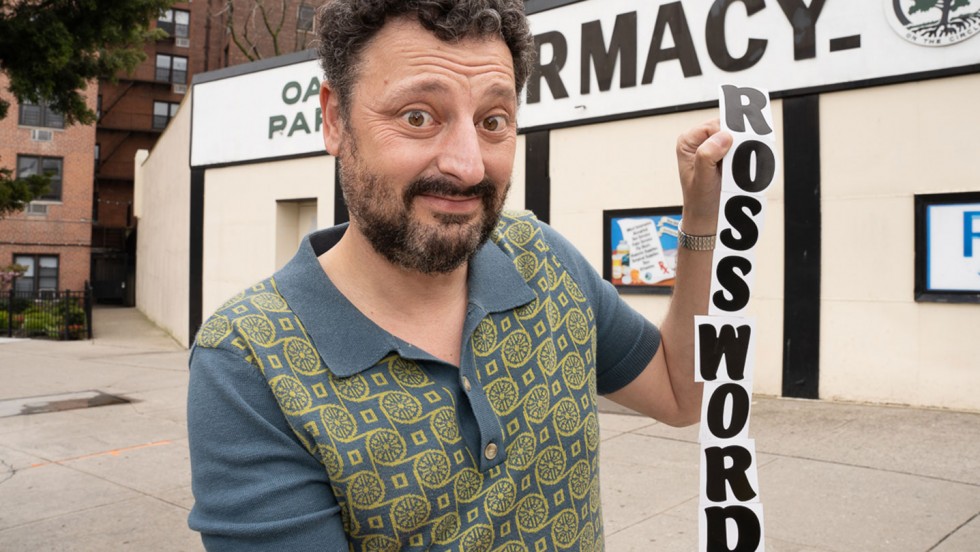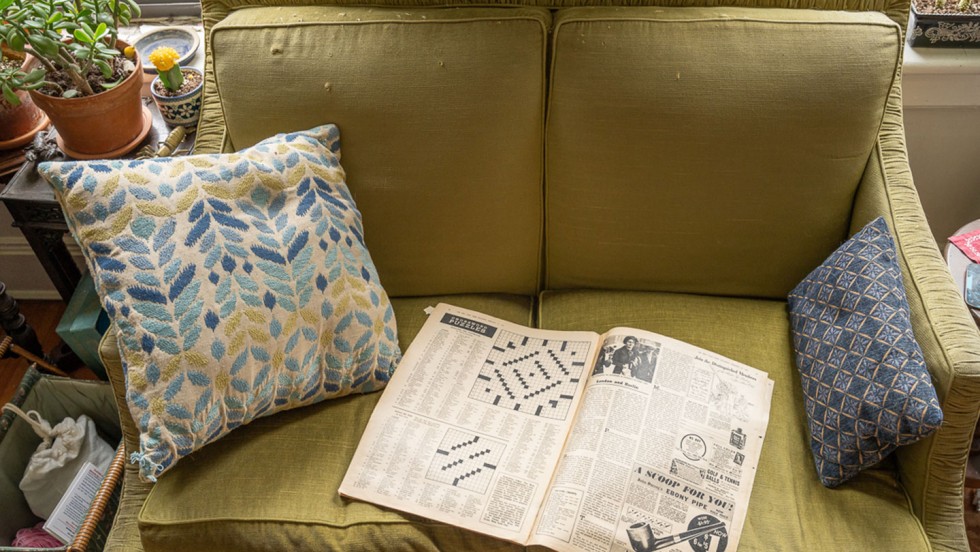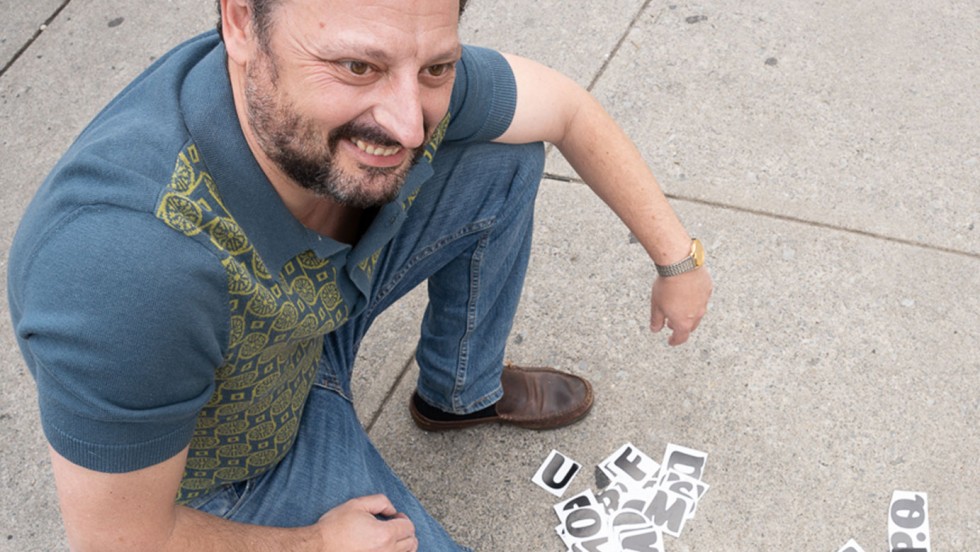A Stroll Down Memory Lane
Bukszpan wrote a Kenyon themed crossword puzzle just for you — complete it on the cover of the print magazine, or you can fill it out online.
David Bukszpan ’02 talks writing, puzzling and his published New York Times crossword.
Story by Carolyn Ten Eyck ‘18 | Photography by Jordan Hollender
"There are words that we don’t use much anymore,” said David Bukszpan ‘02, author of “Is That a Word?: From AA to ZZZ, The Weird and Wonderful Language of Scrabble,” and an upcoming book on the languages of crossword puzzles. “They don’t hold a central place in popular culture. But if the word means something to you, if you know about that thing and like it, then you don’t mind that word coming up at all. In fact, you feel a little bit of joy.”
I felt that spark of joy while sitting in Peirce Dining Hall the morning of Sept. 20, 2016, at the start of my junior year at Kenyon. As usual, I was doing the New York Times crossword with my friend, struggling through the Friday grid, when we came to the clue “College where Rutherford B. Hayes was valedictorian.” For many solvers that morning, this might have been a source of frustration — a “how am I supposed to know that?” type of clue. But for us, as we giddily penned KENYON into the six empty boxes while sitting in the heart of Gambier, it was a source of pure glee.
That glee still returns to me while solving crossword puzzles, often mingled with a kind of exasperated triumph whenever a pun or piece of wordplay clicks in my brain and the answer finally reveals itself on the grid. I felt it while solving the Jan. 4, 2022, crossword, a themed puzzle created by Bukszpan that celebrates (what else?) crosswords, and has the honor of being the first time SEXYELF appeared as an answer in the Times crossword (in response to the clue “Risqué costume for a holiday party”).
Bukszpan’s new book, “Crosswordese: The Weird and Wonderful Language of Crossword Puzzles,” is scheduled for publication next spring. I talked to Bukszpan about our shared passion for the “strangely unemotional activity” of puzzling, his undergrad encounter with famed crossword editor Will Shortz, and the differences between writing stories and creating crosswords.




First things first: you published a New York Times crossword this year! Any Easter eggs within the puzzle that you can share?
I did happen to use the answer SHORTS as an homage of sorts to the current editor, Will Shortz. Sadly, the editors changed my favorite clue. While many solvers liked the clue the Times used for SHORTS — [Word after booty or Bermuda] — I preferred what I had originally: [“Men in ___ are disgusting.”—Fran Lebowitz].
Eagle-eyed solvers might have also noticed that I tried to include other crossword-related answers, like GRID and SAWFIT (and “box” via BOXKITE). I also thought it was APT and even a bit SUAVE to sort of NAMEDROP or even NESTLE in one of my favorite constructors, Merl Reagle, by including the answer REGALE. And of course, the puzzle, about how crosswords offer a short escape from life’s troubles, starts with ESC, which happens to be just where the key is on a keyboard, in the top-left.
You were an English major, right?
I was! I focused in creative writing. I was pretty close with Fred Kluge ’64, that mensch. I still visit him when I come back to campus. I got to catch up with him at my 20th reunion this year. Once, driving to New York from Columbus, where I was getting my M.F.A. in fiction at Ohio State University, I wanted to quickly show my wife around Kenyon. I wasn’t sure we’d have time to see Kluge and hadn’t let him know in advance. But the moment I got to Chase Avenue I had to slam on the brakes: I almost ran him over.
I took “History of English Language” with the late Bill Klein. I’m sure that course laid the foundation for my eventual interest in words.
My senior year, Will Shortz brought his road show to Kenyon. Higley Auditorium was packed. He did a version of his NPR puzzle bit: rearrange a state’s letters to make a fish and a prize, etc. I answered one correctly and got to keep going until I was stumped, and I put a nice little streak together. It was likely only about a half-dozen answers but I thought, “Oh, maybe I’m good at this.” Looking back, I think I was just a little less drunk than most other folks there. Anyway, I tucked it away. I didn’t do crosswords at that time. I’ve always liked jokes, puns and wordplay, but I didn’t really get into crosswords until the pandemic.
You wrote a book on Scrabble in 2012, “Is That a Word?” Was that an early interest of yours?
My parents were teachers. They had a way of tricking me into enjoying educational things. I remember my mother — she was a math teacher — and she’d say, “If you finish all your homework quickly, I’ll give you some exercises from the math workbook I use with my students who are two years older than you.” She totally suckered me. And as a family, we played Scrabble. When you’re a kid and see a way to potentially beat your parents at something, it’s all the incentive you need.
There was a huge Scrabble fad, I would say, around when Words with Friends came out. I was self-employed (read: had recently been laid off ) and thought, “What about a book that would give people a fun way to learn some of those crucial, weird, short words and their definitions?” I strung them together in wacky tongue twisters and strange sentences, and the illustrator made hay with the images.
During COVID times, I started solving crosswords and again I noticed that a bunch of odd-ball short answers were the key to success. At first, they were a nuisance: How am I supposed to know the three-letter name of some home-run hitter from the 1930s?’
Then I started to understand. Just as Scrabble has its own set of useful words — a sister-tongue to English I like to call “Scrabblish”— crosswords pull from a lexicon known as “crosswordese.” In the parallel universe of crosswords — maybe we can call it the cruciverse — a ballplayer like Mel Ott is much more famous than Derek Jeter. I started making a list of all the crosswordese I found most useful and interesting and thought, “Oh, I could have some fun with this.”
Crossword construction seems different from creative writing — it has that analytical aspect. How do you balance those two parts of your writing brain? How would you weigh making a crossword against writing a short story?
For me, making a crossword comes a bit easier, mostly thanks to its constraints. You know going in just about how many answers it’ll have, how many blocks, and it’s got to be symmetrical. You need to have a plan before you start to build a puzzle. Most crosswords are themed, of course, so you start there.
Having plotted the theme answers, next comes finding the small words — the “fill” — to make everything connect. This is primarily dictated by the shape of the grid and the position of the answers, so again, constraints help. But within them, surprising opportunities arise to include fresh answers and hatch up original clues.
When I write fiction, I have a much smaller sense of what I’m going to do. The main question is what you want to say, and then how: plot, style, tone, characterization. Something strikes me — an object or an image, a moment or character. Then I build out and the themes take shape organically. I think more deeply about things when writing than I do in the hurry of everyday life. With crosswords, it’s not about deep thinking so much as playful thinking. One’s an art; the other’s a nifty little craft.
Language is central to both. And changing a word can have big repercussions. But the greatest similarity is that each sends the audience on a type of journey, so I think a lot about the reader or solver’s experience as I work, particularly regarding discovery and payoff.
You started getting into crosswords fairly recently. What was the timeline between getting into solving and trying your hand at constructing puzzles?
Once I started solving puzzles, it wasn’t long before I wanted to start building them. I submitted three or four puzzles at first, which were, looking back, absolutely embarrassing. Another similarity between writing short stories and creating crosswords is the rejection! Submitting, then crossing your fingers for months until hearing “no,” but then latching on to the “we hope you’ll send us something again.” Fortunately, the puzzle editors at the Times have been very kind and supportive, pointing out what I was doing wrong and how I could improve.
Writing the book, I thought I’d create a crossword to close each chapter, sort of riffing off that chapter’s content. The introduction covers the history of crossword puzzles, and I was researching Margaret Farrar, the first editor of the New York Times crossword. I came across a quote of Farrar’s, and it was so spot on. She spoke precisely to something I loved about crosswords; I immediately closed the book and started building a puzzle, using her quote as the theme: “YOUCANTTHINK/OFYOURTROUBLES/ WHILE-SOLVING/ACROSSWORD.”
The theme grew even more meaningful for me than I could have suspected. After I’d submitted the puzzle, my father was diagnosed with stage four pancreatic cancer. I was in Florida with him when the Times wrote to say they were accepting the puzzle, but there were some kinks they wanted me to work out: The first letter of one answer put a strain on part of the grid. As I toyed with alternatives, I lost myself in the work. Though I was constructing instead of solving a crossword, Farrar’s words, stuck there in the middle of the grid, rang true.
It feels necessary to have those little escapes in life. It’s not mindless, but it’s not mindful either. You are with it and also beside it, whether you’re solving or creating a puzzle. The process is analytical and creative, yet somehow it becomes almost mechanical.
I do feel like that’s a big reason why a lot of people turned to writing or solving more puzzles during the pandemic. I can focus on this, even if I can’t focus on reading or writing. Bingo. It can be a strangely unemotional activity. The Times and other editors understand that and so they avoid having certain answers in there, through the so-called “Sunday morning breakfast test.” The idea is to not have answers that would put somebody off their oatmeal if they were solving at the table. You’d like to not have to think about deep things, especially grave things. In fact, that’s why if there is an answer like CANCER in a puzzle, it will practically always be clued as the astrological sign, not the disease. The puzzle can be a momentary refuge from bigger, let’s say, less semantic problems. And man, I think we’ve needed that a lot the last few years.
Oddly enough, it’s also a way to feel connected to other people. Because as much as it’s a solitary act to solve a puzzle, you still know you’re facing the same challenge as so many others that day. And — crosswordese notwithstanding, once you get it down — there’s a common set of things that are reasonable to expect solvers to know: a novel that we may have read at some point, the name of a president, etc.
That reminds me — Will Shortz was once asked to describe his job as a crossword editor. And he said that he was a curator. What he’s trying to do is decide, “Oh yeah, that deserves to be in a puzzle because enough people know about it.” The underlying idea that we’re all in this together, sharing the same cultural touchstones at the same time. Perhaps it helps explain why Wordle became so popular at this moment, too.
Do you think having a Kenyon education helps make a good crossword solver?
If you have a liberal arts education, you’ve at least dabbled in history and the classics and poli sci, and it opens you to getting a lot out of puzzles. Or at least recognizing what should go in them.
For instance, ILIAD comes up a lot. Usually, you don’t have to remember much to answer the clue. But when you do arrive at ILIAD, maybe you remember reading it and being moved by it. Or even sitting in Ascension, hearing a lecture on it, seeing the dust mites glow through the slanting (too early in the morning!) light. Suddenly you’re back at that desk, breathing that hot, stuffy air. It makes the solving experience so much richer.
A five-letter word for cooler? David Bukszpan ’02, photographed in his Brooklyn, New York, home, where even the fridge nods to his love of wordplay.
Bukszpan wrote a Kenyon themed crossword puzzle just for you — complete it on the cover of the print magazine, or you can fill it out online.
Kenyon alumni and faculty share their thoughts about the power — and the limits — of storytelling in the fog…
Read The StoryThe puzzling past and promising future of one of Kenyon’s most storied buildings.
Read The Story